I’m quite proud of the second piece in this series, where I argued that it really is bullshit that the government makes it illegal to build the essentials of life near where people actually live. This is something the Traffic Troons very rarely bring up, but just because they say it doesn’t mean that I’m going to pretend that they’re wrong. Similarly, they bloviate about walkability a lot, and having walkable neighborhoods is a great thing.
I’m not getting Finkled into saying that walkability is bad. I’m not willing to accept that these anti-White pro-crime cunts actually care about walkability. It’s just like when they call themselves socialists while being the most obsequious whores towards Big Business, up to snitching on normal people for breaking Mark Zuckerberg and Jonathan Greenblatt’s terms of service.
In a similar vein, I’m not going to pretend that trains and other fixed path infrastructure methods of transportation don’t have some advantages that occasionally make them the absolute correct method for certain transportation needs. These guys have this really annoying obsession with them, and love to bloviate about their upsides while ignoring their downsides. Nowhere is that more evident than this reddit genius explaining how California’s high speed rail is not just not a catastrophic failure, but actually good.
You’d think it’s a parody, but it isn’t. This is from the heart. But we don’t need to whine about the earth melting, or pretend that spending $105 billion dollars to build a rail line from Mercer to Bakersfield, operational next decade, is anything other than a point and laugh failure to understand why trains haven’t quite gone the way of the horsie.
Now I do stand by what I said in the conclusion of my piece on horses. The decline of horses was not due to an illegitimate conspiracy by Big Automotive to make people think that horses were inferior to cars, and the decline of trains was not due to some illegitimate conspiracy by aircraft and automobile manufacturers. But decline is not disappearance, so what are the advantages of trains anyway?
It comes down to two things, only the first of which we’ll cover today. First, trains can take advantage of having their own (mostly) fixed path infrastructure to decrease costs and increase throughput on a drastically smaller amount of fixed routes. Second, and least important, trains have lower rolling resistance, and, due to the first reason, can have lower effective wind resistance relative to their payloads.
THE ADvantages of fixed path infrastructure
The first advantage is pretty easy to understand. Imagine you live in White Rock and need to go to school at the Kwantlen location in Surrey. Well, that might take a long time during rush hour.
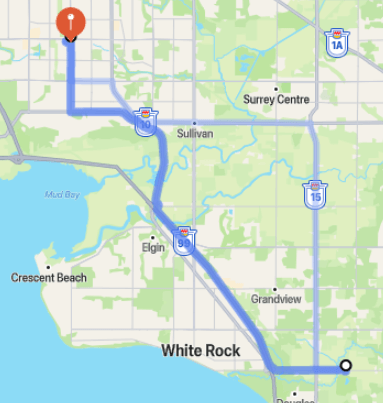
But what if we just spawned in a road that took you there directly. Would that be faster? Having your own private road that goes from your house directly to the university?
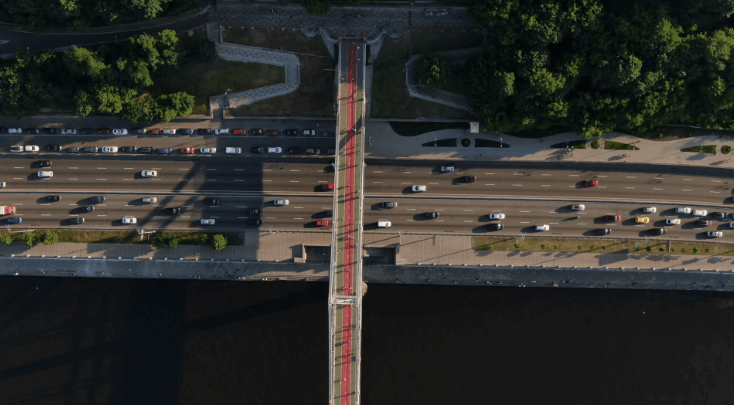
Sure seems that way. But the problem is that it only goes to the university, and now we want to go to the Walmart. Unfortunately, the congestion can be real bad at this time of day.
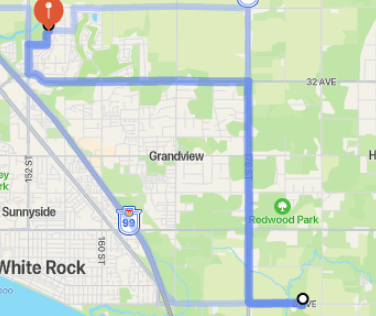
But, hold on a second. What if we built another path that went directly to the Walmart? Sort of like this, but we kicked the pedestrians off.

Boy that sounds like it’d be really good for us. But there’s a problem. Now we got back and we want to see our friend. Normally this would be no problem. Sure, the road to our friends house is somewhat congested at this time, but we have a way to avoid this.
 That’s right, we just take the overpass that goes directly from our house to our friend’s house. It’s like this, but with no pedestrians and just our car.
That’s right, we just take the overpass that goes directly from our house to our friend’s house. It’s like this, but with no pedestrians and just our car.
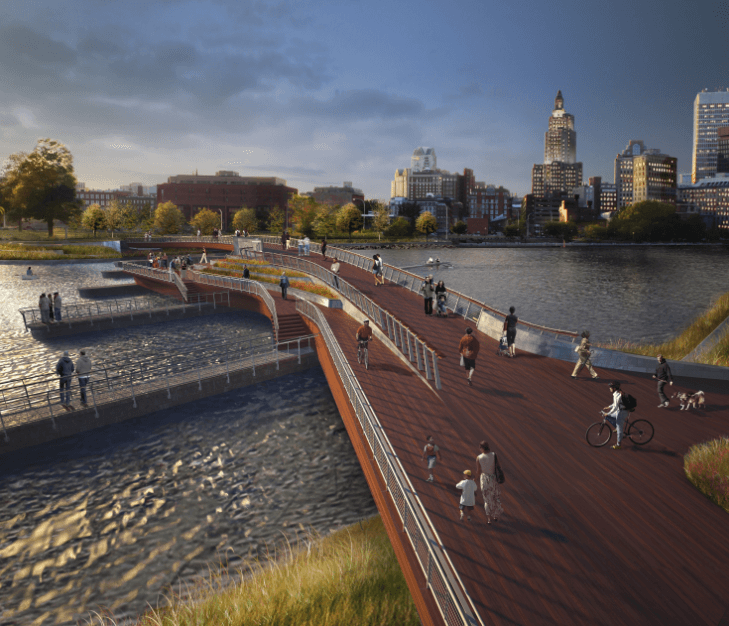
But there’s a problem. Because we’re now currently at the Walmart, but we want to go directly to our friend’s house. This is bad, because we don’t have a special road that goes directly to our friend’s house from Walmart. So we would need to go back to our house, and then use the special road to our friend’s house. Except then there’s a problem, because we want to go directly to the university after this, and there’s no special road just for us that goes directly from our friend’s house and ends at the university.
This is starting to look a little bit silly. We need a road build directly between all the places we want to go to. I mentioned three of them, but we still have our favourite restaurant, the hockey rink, our girlfriend’s place, the gym, the park, the bank, and our favourite grocery store. That’s 10 places that we need to build special roads that go directly to, and for real convenience, we need 10 roads from them to each other. But even then, what if we want to go somewhere in a semi-random area that’s not the exact location where we want to go? Well then, gasp, we might need to use the general road system like a real peasant.
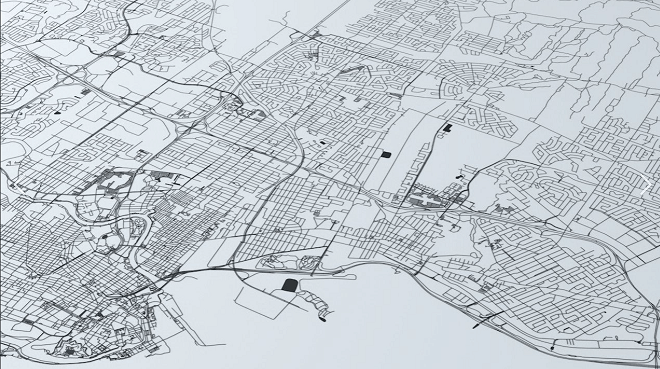
Above is a map of Quebec city that I found online. I didn’t search out this city in particular, but it’s a beautiful map. Take any two arbitrary points on the map try to reason out the path to get from one place to the other. Keep doing this for a while, and you’ll notice that you occasionally re-use the same roads, or maybe just part of the same road. Then you turn off in a different area and use part of a road that you used for a later journey.
Then, imagine that you had to build direct roads between all those locations. That would be impossible and hideously expensive, right?
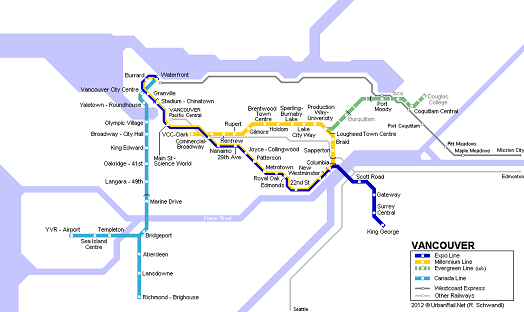
Above is a map of the Vancouver subway system. I have plenty of experience with the straight blue line on the left. It’s a pain in the ass to get to, and only took me in the general vicinity of where I wanted to go. But I don’t necessarily blame the government for that, because subways are extremely expensive.
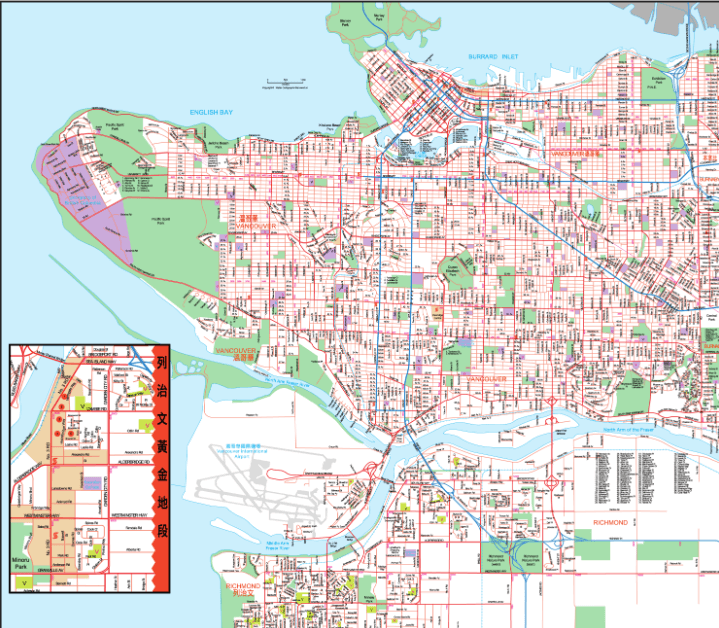
Here is a map of Vancouver above ground, with the roads included. They don’t show all the roads in Richmond for some reason, but I think you can get the general point, which is that if you have a car you can get to exactly the point where you need to be at using the connected road network. And you can get there from your house, since your house is connected to said road system in the first place. We don’t need a special purpose road for this trip, we just need your driveway to turn onto a quiet residential street and you’re all set.

Let’s get back to our personal overpass. Aside from personally servicing us, this is not as far fetched as it seems at first glance. After all it’s perfectly possible to build roads over of a city if you can build railways over a city.

But it would largely be a waste of time and money, since the advantage of automobiles is their ability to easily and quickly get on and off various roads, as well as start and stop quickly. Automobiles are what enable a general road system, or at least wheeled vehicles do. Remember, there were horses on the same exact roads as automobiles before cars were invented, something the urbanites are loathe to admit. And yes, this was one hundred years after the invention of the train.
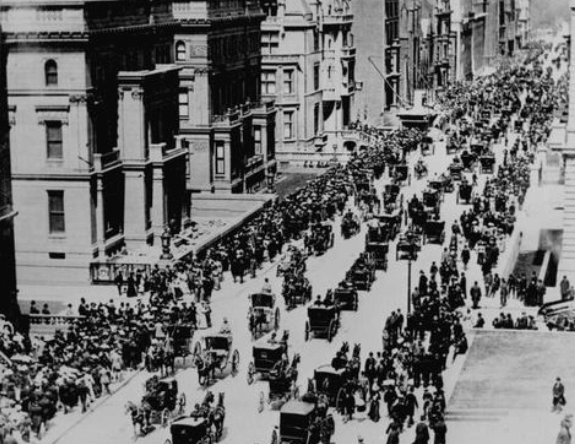
It’s absurd to build a road just for us, so what if we let the general public use those special made roads that we use to go from our house to Walmart? Well, there’s probably not much demand for that. But if there was, the congestion could be a lot better for the same throughput, compared to a real street, since we don’t have to deal with all the traffic shocks that you get from people navigating the general purpose road system and turning on and off certain roads. For instance, we don’t have to worry about road lights versus stop signs versus roundabouts, since there are no intersections.
Using the general purpose road system, even if there’s light traffic on the road, and no congestion, you still need to stop at traffic lights, stop signs, and slow down for roundabouts, in addition to not going directly to your destination. With our direct road we can guarantee that we will have a smooth and consistent driving experience the entire way there, until the traffic is much higher to the point where we start getting shockwave traffic jams.
If we were extremely stupid then we would do what Elon Musk did, and not actually create a direct path between two points, but have a stop in between. That way we can have massive congestion due to the irregularity of traffic throughput, and enjoy a traffic jam underground. Thanks, Elon!
But a lot of congestion is caused by people not being able to predict other people’s behaviour and overcompensating, as seen with the traffic shockwave video above. You can see something similar below.
This will not be an issue for us, since it was pretty ridiculous to build a special overpass road between my house and my friend’s house so there’s no traffic. But there are real areas where there is a lot of very predictable traffic. In those areas what we can build is a bus station where we load everyone on, and then they go on the bus down the special purpose road that we built and towards their destination. Where are we going to do this? Well how about all the places where the subways and light rail currently operate?

There is nothing stopping us from doing this, especially if we have buses that run on electric power. Just put some overhead electrical lines down there and we’re good to go. That buses have rubber wheels with air in them does not mean that we can’t build their own dedicated roads, underground or otherwise, for them to travel on. You don’t need to have steel wheels to reap the advantage of fixed path infrastructure.
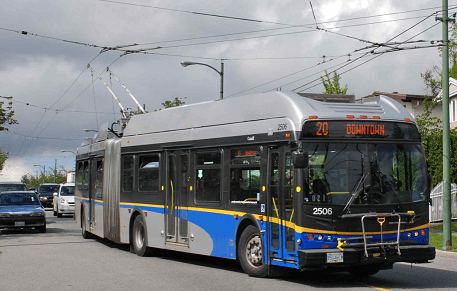
This is the premise behind Bus Rapid Transit. Essentially you build infrastructure similar to what you would for a subway, and then put buses on there. There are a few advantages to this, such as buses being able to go uphill without crying and shitting their pants, unlike trains.
I’m not particularly for or against this kind of thing. My point is not to sell Bus Rapid Transit to anyone, because there are efficiency benefits in terms of lower rolling resistance to having trains. The point is that the main advantage of trains, especially inside cities, is that they can achieve higher throughput not due to steel wheels, but due to fixed path infrastructure.
Here’s yet another bugcreature soying out over “induced demand.” This is too tiresome to address again, but he starts out with the following very relevant blurb.
Pretty much everyone knows that public transit is more efficient at moving large numbers of people than private transportation.

Yes, from pre-designated destinations to other pre-designated destinations and assuming that there exists demand in the first place. Let’s take another look at the general purpose road system in a city, this time Toronto.
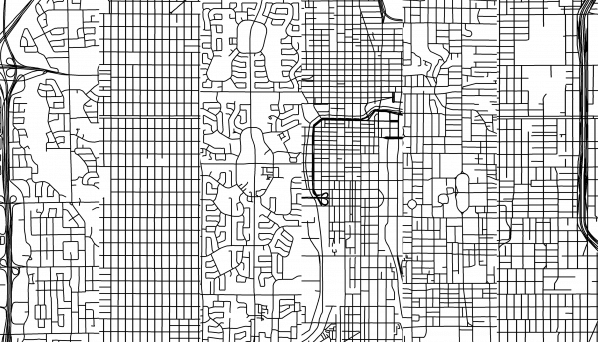
This actually might be Chicago. I’m not sure.
Again, pick some random points on the map, and assume you’re getting from one point to another. Keep doing this with various points, and notice how often you use only a small part of any particular road. Now try going to a grey area using the subway lines, and see how much further away you end up from your destination. Keep in mind that Toronto has one of the most extensive subway networks of any city in the world, albeit one that is currently facing 30% less ridership due to rampant crime.

Saying that “muh trains are more efficient,” or “public transit is more efficient,” by some arbitrary definition of efficiency whereby throughput is prized above all else is like saying that fixed function hardware on the CPU is more power efficient, therefore we shouldn’t have the general purpose hardware that does 99% of the things that we want our computers to do. Of course if we build custom infrastructure that goes directly from point A to point B then it should be more efficient at going from point A to point B. But the other roads are used for all the irregular traffic. The seemingly random trips, from the perspective of a city planner, that we make on our own.
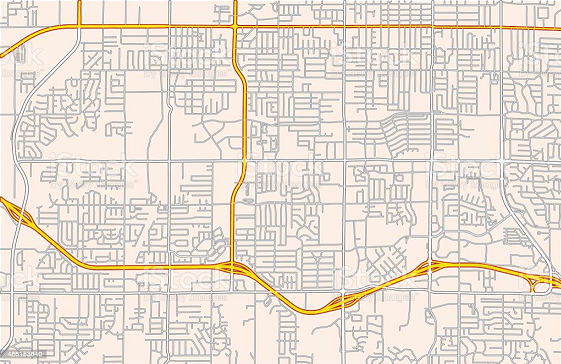
If you have a city where there are 10,000 destinations that people could want to go to it is not possible to build custom overpass roads or subway tunnels directly from each of those points to each of those other points. Instead you build a road network. That was true long before we had automobiles, which is why horses were everywhere shitting up a storm.

Saying that congestion can be fixed by fixed path infrastructure, usually trains but sometimes bus lines, gets really tiring. In some cases this might be true, but simplistic answers like this are not productive, no matter how much snark they are accompanied with. Case in point.
I get that it might make sense at first glance to think that a rail running alongside a highway does the exact same thing as the highway, but it doesn’t. Not even close. If the train stopped every time there was an on or off ramp the speed would be atrocious. But even if it wasn’t, when have you ever just stopped somewhere right along the highway? It happens, but it’s rare.
It’s much more likely that you will go along a highway for a time, then turn off and drive for 10 minutes to your destination, a friend’s house. Then the next time you use that highway you turn off at a different location and drive for 5 minutes to get to the hockey rink. The third time you use that highway you’re going home from a concert, stopped at a friend’s house afterwards, and got on at a totally different point than you ever had before. Hell, maybe you even get off at a different stop than usual to buy groceries, and then use the streets to get back to your place. You can do this because you can personalize or customize your journey with a general purpose road system.

Remember this guy? That’s Adam Something. He said that children used to play on the streets before cars were invented. He’s also responsible for this “helpful” graphic explaining “induced demand.” I made fun of that before, but now I want to bring it up for a different reason.
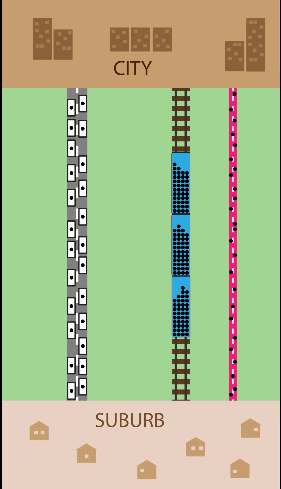
He created a premise where there was this grey tube representing driving, a blue tube representing riding the train, and a red tube that represented biking. At the end, biking and riding the train were holocausted by increased road capacity, which is hilarious since the implication was that no one wouldn’t drive if given the choice.

This snarky midwit did something that these people do a lot, which is simplify out most of the advantage of an automobile. Despite that, he still assumed that everyone would drive if the highway wasn’t congested, which is a great self-own.
But also not true, since the main point of road vehicles is that they have access to the general purpose road system, so you can go from your personal starting point to your personal destination, instead of a fixed starting point to a fixed destination, set by planners looking at population maps.
A lot of these Urbanites use a simplified model like he did above where it’s just CITY and SUBURB. Then the geographical size of both areas is concentrated down to an area the size of a sticker. Therefore once you’ve reached CITY from SUBURB, the journey is over.
Then they say “Lolololol, the highways into CITY can’t move as many people as some rail lines from SUBURB could therefore bad.” Unfortunately for real people your destination isn’t CITY, it’s a very specific place in or around the city.
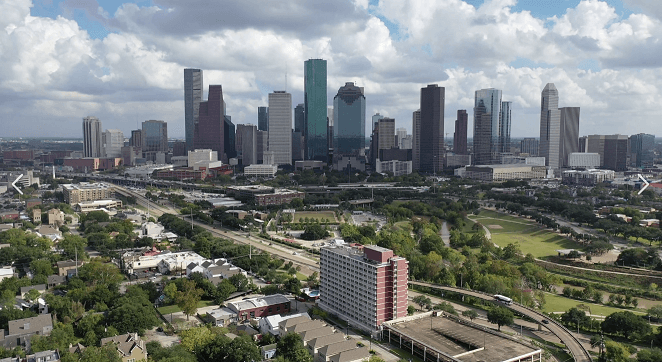
Houston, Texas
Houston, Texas and the Katy Freeway in particular really perturb these guys petunias. Apparently we just need a train from THE SUBURBS, which are the geographical size of a sticker, to THE CITY to fix the congestion problem, according to Alan Fisher. But let’s pretend that everyone could simply be teleported to the center of Houston’s downtown area.
What if they don’t need to be in the downtown area? What if they need to be in that red building at the front of the picture? Or the far left side of the city and off into the distance? It is possible that it would take them longer to get to their destination if they were teleported into the city and could avoid the congestion on their way, but didn’t have their car with them to get to the specific destination they needed? In some cases undoubtedly yes.
But we don’t need to focus on people’s individual custom trips, because muh throughput. Oh The Urbanity! makes this point.
This is the Don Valley Parkway, a six lane highway in Toronto. If you sit in one place at rush hour and watch the DVP you could see six to maybe 8 thousand people in those cars pass by in the busier direction over the course of an hour.

He includes this graphic, presumably taken from real studies. Although I do question the validity here, considering the fall in traffic over the years.
If you do the same thing in the nearby Yonge Subway you could see thirty thousand people per direction per hour. With ongoing signal upgrades pushing that up to 40k people in the future.

You’ll see about 35% less than that, considering that no one wants to ride the crime-ridden Toronto subway system. But you’ll see even less than that, because this graphic is a little different than the first one.

Jaime can we zoom in on the upper left quadrant pls?

Nice to see that we’re comparing the observed traffic flow for cars, while merely bloviating about the imaginary, theoretical passenger movement for the subway.
That’s an enormous advantage for the subway, even before you consider that it only takes up two lanes, mostly underground. Subways don’t carry freight, but when it comes to carrying lots of people mass transit wins hands down, and it’s not even close.
He then once again shows us this “helpful” graph that he made, explaining the different in ridership.
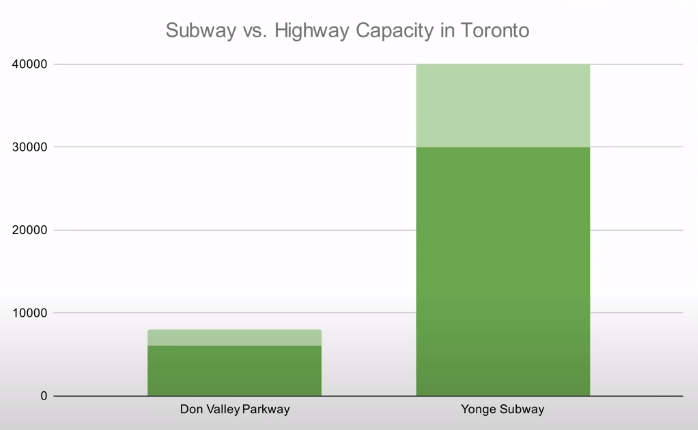
I have a lot of problems with this, but mostly it’s a complete and utter non-sequitur. Of course the subway moves more people, that’s the advantage of having fixed source and destination transport. We can’t cram everyone who uses the Don Valley Parkway together, because they’re not getting off at the same point, and they’re not starting from the same point. Also, the DVP is just one of many roads that people can use to get out of Toronto. So the question is not “are we moving arbitrary numbers of people with arbitrarily high throughput,” but rather “are we satisfying the entire transportation demand of the general public.” The subway moves people along the subway. The DVP connects to other roads and makes a potentially infinite number of custom trips possible.
I can believe that the Yonge subway line transfers three or four times the people over some arbitrary distance, but unless they’re homeless people who are really interested in changing up their bathroom residences, no one is going from their true source to their true destination. However, it is possible that, should the area be populated enough, they are getting close enough to their destinations that they can walk. In the case of very high density cities subways can make a ton of sense. Frequent bus routes, somewhere in between rail and personal vehicles in terms of fixed versus flexible, can also make a ton of sense.

Don Valley Parkway
That the fixed, and therefore high throughput subway has more throughput does not mean that the general purpose road system == bad. We can’t just build a subway line from the workplace of every individual person directly back to their houses. The Don Valley parkway may service less peak traffic, but the people on there are taking different on ramps and off ramps and going to their more spread out areas where they then navigate different streets to take their own way home.
What if one day you take one off ramp past where you usually get off to go home. Then you navigate the urban streets, taking a path you’ve never taken before to end up in a commercial area to pick up some flowers. Then you navigate more streets to end up at your girlfriend’s house. Then you take a path you’ve never taken before to end up at your local grocery store, before finally taking the series of streets necessary to get home.
That is a custom trip. It’s highly likely that you were the first person to ever make that trip. It is not possible with fixed path infrastructure. You are not doing that on a subway, you are going down the line.

Ever been to an airport and seen the conveyor belts? They can be pretty fun. They also get you from their starting point to their ending point faster than you can walk.
Now imagine someone saying that these conveyor belts are better than regular floor, because they have higher throughput, and are more calorically efficient because people don’t have to expend so much energy moving. But they don’t mean “in the specific cases where it makes sense,” they mean in all cases.
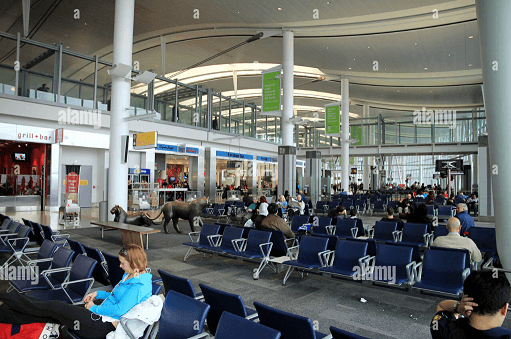
So here we are at the waiting area in Toronto Pearson Airport. Imagine you decide to get up and go wander into the book store to see what they have. Your spouse gets up at a later time to go buy a coffee. On your journey you then walk down to the bathroom, before finally walking to the window so you can watch the planes take off for a while before wandering over to your spouse who is now at a different shop buying a trinket for your child waiting at home. Then you both go back to your seats to get your luggage because you need to walk to the back of the line because it’s time to board.
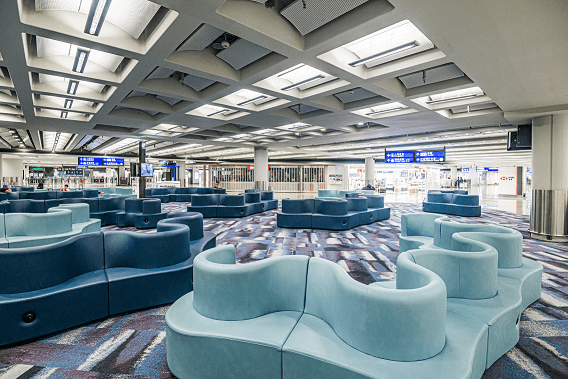
Now imagine that some snarky reddit genius steps in and says “conveyer belts use less caloric energy to traverse, so we’re getting rid of the floor.” And no matter how many times you explain to them that the disadvantage of slower movement is more than offset in most cases by being able to move to exactly where you want to go is constantly bloviating about how the throughput is higher on the conveyor belts.
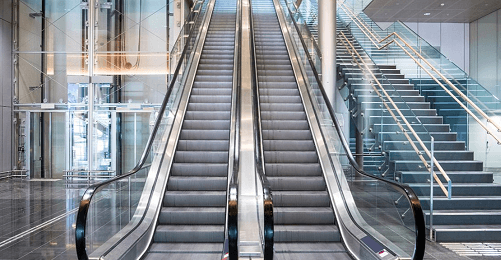
Escalators are fixed path walking infrastructure that makes sense, since there’s little benefit to swerving around randomly on the stairs.
The purpose of the General Purpose Walk Infrastructure (ie. regular ground) is that you can make the custom trips that you want to make. The purpose of pedestrian conveyor belts is to make one specific trip faster. Saying that conveyor belts are “better” because they make one specific trip faster is incoherent stupidity, but that’s exactly the kind of “logic” that these people use time and time again in favour of mass transit.
That “Oh The Urbanity!” video is annoying, but nothing compares to Alan Fisher once again. He talks about long haul trucking, something I am quite familiar with, and I’m not letting him get away with his idiotic snuck in premises there. But for now we’re skipping ahead to 9 minutes into his video on 2 day shipping. I’ve started it from the correct time.
Rail will always be more efficient than trucks, not just in fuel efficiency, but also in land use.

“Conveyor belts will always be more efficient than regular floor. Not just in caloric efficiency, but also in land use, when we define max throughput to be the purpose of the floor infrastructure.”
Here is I-295, the highway that primarily serves the warehouses in the same area. 295 is pretty well known in the area for backing up many places in South Jersey with heavy traffic.
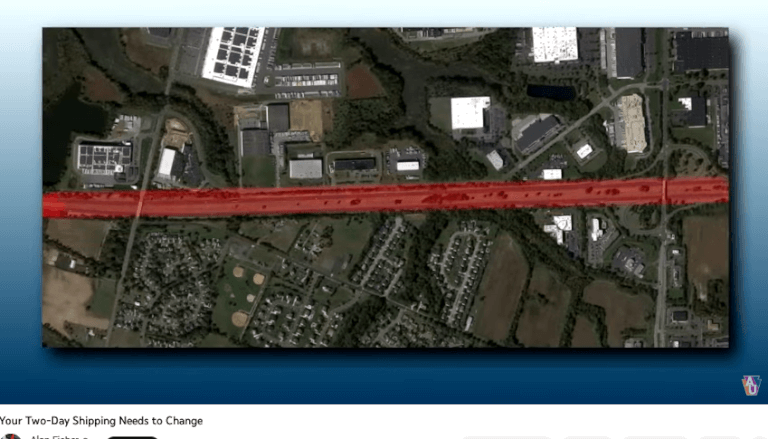
He includes this picture of the I-295 highway coloured red.
The same amount of trucks serving the warehouse in the area could either use the highway or could instead use a single track rail line nearby, freeing up the roads for commuters.
You hear that truckers, just drive your tractor-trailers down the rail line instead of the highway.

Yeah, I was confused too when I heard him say that trucks could just use the railway to free up the highway, but he simply misspoke.
This rail line can carry the same amount of freight that the highway can also carry, yet it takes up far less land and has far less pollution.

As a former longhaul trucker it actually makes me chuckle inside that he’s such a moron that he thinks that you can just snap your fingers and have trains magically replace trucks because theoretically the rail could support the shift in tonnage. By this logic, an intercontinental ballistic missile could transport far more tonnage than the trucks, and wouldn’t cause congestion on the roads. So we need to ban trains and go with ICBM’s for our transportation demands.
Trains have the advantage of having low rolling resistance with their steel wheels on steel track. Trucks have high rolling resistance because rubber tires deform during operation.

The fuck does this have to do with anything Alan? I thought you were going to explain to me how exactly we’re supposed to “just” switch from using trucks to using trains, since trucks have access to that general purpose road system that trains don’t, which is kind of important for a lot of freight.
According to CSX the average freight train can move up to four times the amount of goods as a truck can for the same amount of fuel.
But no, we’re just bloviating with misleading statistics about train fuel economy. Although again, trains do have higher fuel economy. They better. They need fixed path infrastructure. If there weren’t benefits they wouldn’t exist.
Plus in the future a rail line like this is relatively easy to electrify compared to the intense charging network that’s required for inferior electric trucks.

It’s gas stations for electric vehicles. I’m not even a fan of electric trucks but imagine not thinking that we can create charging stations. Also, those charging stations serve other electric vehicles. And finally, don’t feel like you need to quantify that at all.
So, is the answer always trains? I don’t know for sure, but the numbers and the statistics sure seem to point that way.

What numbers and statistics? The only statistics and numbers he brought up was the max payload capacity of the railway, and the theoretical peak fuel efficiency advantage of trains. We’re so far from this dipshit solving any real life transportation problems that I would have to do more work assigning him a less stupid position just to knock it down.
Alan, is the answer to the walking problem all-conveyor belts all the time? I’m not sure, but the numbers and the statistics seem to point that way. The number being that people move faster on conveyor belts.
In a future where we must reshape our shipping and statistics to lower our CO2 output towards slowing global warming, and if we want to build a more resilient logistics network against weather, switching from trucks back to trains is the logical answer.
Trains resilient against the weather?

Tell that to this poor guy who had the freak weather incident of “a little rain,” stop him from going up the slight incline. I’d recommend watching in 2x speed because it’s fun.
This is what a logistics network that is resilient against the weather looks like.

By the way, he misspelled “logistics” in his video, and at one point it’s directly over another YouTuber who has “logistics” in his name, making it even more ironic.
And even if we want to use trucks for short trips.
No dude it’s not “if”. We want to. That’s why we used horses for these short trips 100 years after the invention of the locomotive. We’re not magically using fixed path infrastructure to distribute product and people you moron. If we don’t use trucks because it’s outlawed then go back to horses, not to trains.
There are technologies out there that allow for the integration of trucks into rail freight easier, like this megaswing intermodal car.

He, a guy who has clearly never worked in “logestics,” suggests that we just use this One Weird Trick to “integrate trucks into rail freight easier,” in the off chance that we don’t want to ban the vehicles necessary for survival. You see, in the rare case that we do in fact want to use trucks, he’s here to inform us that we can integrate them with rail easier. No quantification of real explanation of the claimed benefit is provided.
To achieve the outcome of increased local freight deliveries some things will have to change. Upgrading rail infrastructure must become a societal priority, and one of the only ways to do that would be to nationalize the US rail network.

Imagine a group of people who make nationalizing things sound gay and retarded. Well, you don’t have to imagine anymore.

Alan Fisher
In the next piece I’ll continue explaining why the general purpose road system isn’t just good for you going over to your friends house, but is a major advantage that trucks have over rail.

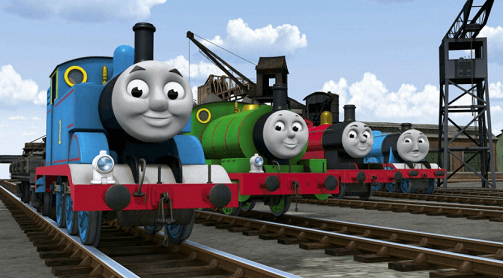




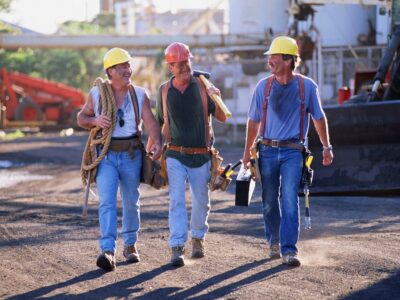






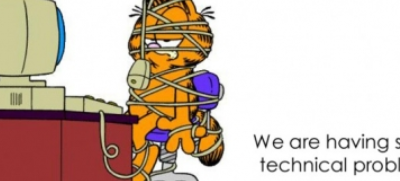
The best mass transit system is in Los Angeles. It solely connects black neighborhoods with government buildings and abandoned shopping malls.
I’m presuming it was entirely designed by a Hollywood script writer who specializes in post-apocalypse films.